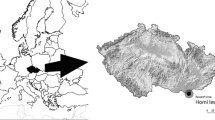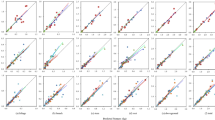Abstract
A dynamic model of regrowth in Typha angustifolia after cutting shoots above the water surface was formulated by characterizing the phenology and mobilization of resources from below-ground to above-ground organs after the cutting. The model parameters were determined by two cutting experiments to investigate the different strategies with flowering and non-flowering shoots after cutting in 2001 and by four cutting experiments to elucidate the regrowth characteristics after cutting on different days from June to September in 2002. A difference was evident both for flowering and non-flowering shoots and for each cutting day. From June to August, non-flowering shoots regrew immediately after cutting, but flowering shoots did not. The shoot regrowth height, number of leaves and shoot biomass were higher with the earlier cutting. The model was validated using the below-ground biomass observed in December 2002 and below-ground dynamics observed in 2003. In the low-flowering shoot zone of the stands, in which the percentage of flowering shoots was small (around 10%), the decrease in below-ground biomass became larger from June (20%) to August (60%). Cutting the high-flowering shoot zone (flowering shoots: 78%) in July 2001, just 1 week after peduncle formation, decreased the below-ground biomass by about 50%. In the low-flowering shoot zone, cutting just before senescence is better for decreasing below-ground biomass with a smaller rate of flowering shoots. The difference of below-ground biomass reduction in non-flowering shoots is mainly due to the decrease in downward translocation (DWT) of above-ground material to below-ground organs during senescence, because of the decrease in regrowth biomass. As for flowering shoots, the decrease in the photosynthate transportation from above-ground to below-ground organs and that of DWT are closely related because they cannot grow again within the season.








Similar content being viewed by others
References
Asaeda T, Bon TV (1997) Modeling the effects of macrophytes on algal blooming in eutrophic shallow lakes. Ecol Model 104:261–287
Asaeda T, Karunaratne S (2000) Dynamic modeling of the growth of Phragmites australis: model description. Aquat Bot 67:301–318
Asaeda T, Nam LH, Hietz P, Tanaka N, Karunaratne S (2002) Seasonal fluctuation in live and dead biomass of Phragmites australis as described by a growth and decomposition model: implication of duration of aerobic conditions for litter mineralization and sedimentation. Aquat Bot 73:223–239
Beule JD (1979) Control and management of cattails in southeastern Wisconsin wetlands. (Technical bulletin 112) Department of Natural Resources, Madison, Wis., pp 1–41
Bonham AJ (1983) The management of wave-spending vegetation as bank protection against boat wash. Landscape Plan 10:15–30
Boyd CE, Hess LW (1970) Factors influencing shoot production and mineral nutrient levels in Typha latifolia. Ecology 51:296–300
Coops H, Velde GV (1996) Effects of waves on helophyte stands: mechanical characteristics of stems of Phragmites australis and Scirpus lacustris. Aquat Bot 53:175–185
Dykyjová D, Ondok JP, Bribán K (1970) Seasonal changes in productivity and vertical structure of reed-stands (Phragmites communis Trin.). Photosynthetica 4:280–287
Garver EG, Dubbe DR, Pratt DC (1988) Seasonal patterns in accumulation and partitioning of biomass and macronutrients in Typha spp. Aquat Bot 32:115–127
Gopal B, Sharma KP (1979) Aquatic weed control versus utilization. Econ Bot 33:340–346
Grace JB, Wetzel RG (1981) Habitat partitioning and competitive displacement in cattails (Typha): experimental field studies. Am Nat 118:463–474
Grace JB, Wetzel RG (1982) Niche differentiation between two rhizomatous plant species: Typha latifolia and Typha angustifolia. Can J Bot 60:46–57
Gryseels M (1989a) Nature management experiments in a derelict reedmarsh I: effects of winter cutting. Biol Conserv 47:171–193
Gryseels M (1989b) Nature management experiments in a derelict reedmarsh II: effects of summer cutting. Biol Conserv 48:85–99
Hellsten S, Dieme C, Mbengue M, Janauer GA, Hollander N, Pieterse AH (1999) Typha control efficiency of a weed-cutting boat in the Lac de Guiers in Senegal: a preliminary study on mowing speed and re-growth capacity. Hydrobiologia 415:249–255
Husák S (1978) Control of reed and reed mace stand by cutting. In: Dykyjová D, Kvet J (eds) Pond littoral ecosystems. Springer, Berlin Heidelberg New York, pp 404–408
Karunaratne S, Asaeda T, Yutani K (2004) Why summer harvesting of common reed is a viable management practice? Res Rep Res Educ Center Inlandwater Environ Shinshu Univ 2:29–34
Knapp AK, Yavitt JB (1995) Gas exchange characteristics of Typha latifolia L. from nine sites across North America. Aquat Bot 49:203–215
Krattinger K (1975) Genetic mobility in Typha. Aquat Bot 1:57–70
Linde AF, Janisch T, Smith D (1976) Cattail—the significance of its growth, phenology and carbohydrate storage to its control and management. (Technical bulletin 94) Department of Natural Resources, Madison, Wis., pp 1–26
Mallik AU, Wein RW (1986) Response of a Typha marsh community to draining, flooding, and seasonal burning. Can J Bot 64:2136–2143
McNaughton SJ (1973) Comparative photosynthesis of Quebec and California ecotypes of Typha latifolia. Ecology 54:1260–1270
Ostendorp W (1995) Estimation of mechanical resistance of lakeside Phragmites stands. Aquat Bot 51:87–101
Patten DR (1975) A diversity index for quantifying habitat “edge”. Wildl Soc Bull 3:171–173
Sale PJM, Wetzel RG (1983) Growth and metabolism of Typha species in relation to cutting treatments. Aquat Bot 15:321–334
Sharma KP, Kushwaha SPS (1990) Effect of cutting of above-ground organs of Typha angustata Bory and Chaub on its growth and total chlorophyll content. Aquat Bot 36:293–296
Shekhov AG (1974) Effect of cutting time on renewal of stands of reed and cattail. Hydrobiol J 10:45–48
Singh SP, Pahuja SS, Moolani MK (1976) Cultural control of Typha angustata at different stages of growth. In: Varshney CK, Rzóska J (eds) Aquatic weeds in SE Asia. Proceedings of a regional seminar on noxious aquatic vegetation. Junk, The Hague, pp 245–247
Tanaka N, Asaeda T, Hasegawa K, Tanimoto K (2002a) Dynamic growth models of Typha angustifolia and Typha latifolia and their competition at the water depth gradient. Res Rep DeptCivil Environ Eng Saitama Univ 31:9–20
Tanaka N, Asaeda T, Tanimoto K (2002b) Effects of water depth on the growth of Phragmites australis. J Hydrosci Hydraul Eng 20:105–115
Tanaka N, Asaeda T, Tanimoto K, Hasegawa A (2002c) An analysis of the growth of Typha angustifolia and Typha latifolia. J Hydrosci Hydraul Eng 20:197–206
Tanaka N, Asaeda T, Hasegawa A, Tanimoto K (2004) Modelling of the long-term competition between Typha angustifolia and Typha latifolia in shallow water—effects of eutrophication, latitude and initial advantage of below-ground organs. Aquat Bot 79:295–310
Ulrich KE, Burton TM (1985) The establishment and management of emergent vegetation in sewage-fed artificial marshes and the effects of these marshes on water quality. Wetlands 4:205–220
Ulrich KE, Burton TM (1988) An experimental comparison of the dry matter and nutrient distribution patterns of Typha latifolia L, Typha angustifolia L, Sparganium eurycarpum Engelum and Phragmites australis (Cav.) Trin. ex Steudel. Aquat Bot 32:129–139
Weisner SEB (1993) Long-term competitive displacement of Typha latifolia by Typha angustifolia in a eutrophic lake. Oecologia 94:451–456
Author information
Authors and Affiliations
Corresponding author
Appendix
Appendix
Governing equations of rhizome, roots, new rhizome, shoot and panicle are as follows:
The notations are listed in Table 3. The above-ground plant stand was stratified into 1-cm horizontal layers in which the dry matter budget and elongation were calculated separately. For mobilization of stored material from rhizome to shoots, respiration, mortality and shoot elongation, see Asaeda and Karunaratne (2000). Figure 9 shows the relation of each term in the five governing equations.
Rights and permissions
About this article
Cite this article
Tanaka, N., Watanabe, T., Asaeda, T. et al. Management of below-ground biomass of Typha angustifolia by harvesting shoots above the water surface on different summer days. Landscape Ecol Eng 1, 113–126 (2005). https://doi.org/10.1007/s11355-005-0014-0
Received:
Revised:
Accepted:
Published:
Issue Date:
DOI: https://doi.org/10.1007/s11355-005-0014-0





